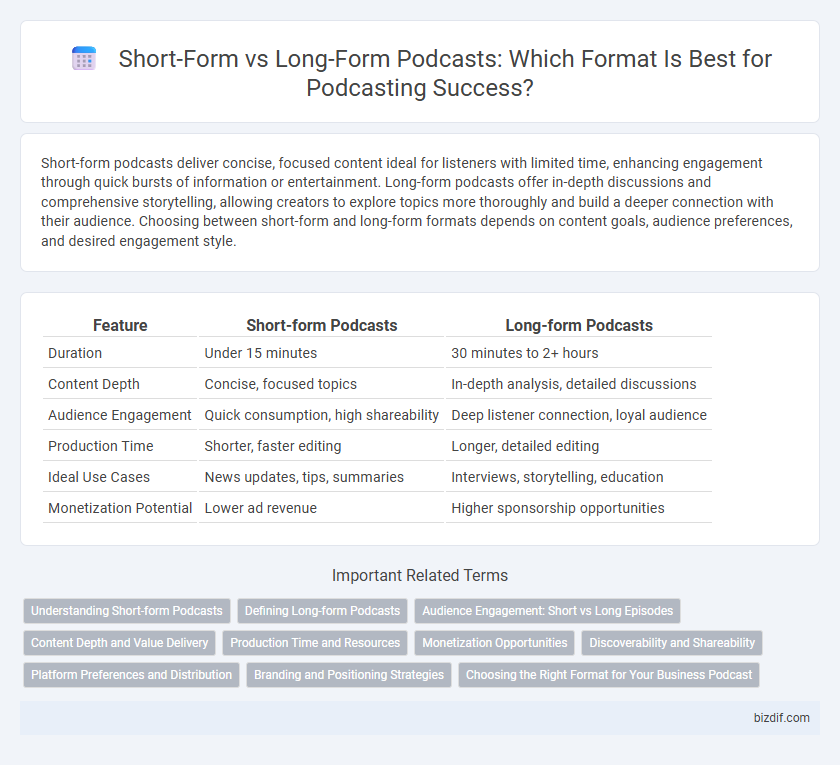Short-form podcasts deliver concise, focused content ideal for listeners with limited time, enhancing engagement through quick bursts of information or entertainment. Long-form podcasts offer in-depth discussions and comprehensive storytelling, allowing creators to explore topics more thoroughly and build a deeper connection with their audience. Choosing between short-form and long-form formats depends on content goals, audience preferences, and desired engagement style.
Table of Comparison
| Feature | Short-form Podcasts | Long-form Podcasts |
|---|---|---|
| Duration | Under 15 minutes | 30 minutes to 2+ hours |
| Content Depth | Concise, focused topics | In-depth analysis, detailed discussions |
| Audience Engagement | Quick consumption, high shareability | Deep listener connection, loyal audience |
| Production Time | Shorter, faster editing | Longer, detailed editing |
| Ideal Use Cases | News updates, tips, summaries | Interviews, storytelling, education |
| Monetization Potential | Lower ad revenue | Higher sponsorship opportunities |
Understanding Short-form Podcasts
Short-form podcasts typically last under 15 minutes and concentrate on delivering concise, focused content that caters to listeners with limited time. They often emphasize high engagement through quick storytelling or targeted insights, making them ideal for daily commutes or brief breaks. Audience retention rates tend to be higher in short-form formats, as their brevity aligns with modern listening habits.
Defining Long-form Podcasts
Long-form podcasts typically exceed 30 minutes, often lasting an hour or more, allowing for in-depth discussions and detailed storytelling. These episodes provide comprehensive exploration of topics, featuring interviews, narratives, and complex subject matter that engage dedicated listeners. The extended format supports audience immersion and fosters deeper connections between hosts and their audience.
Audience Engagement: Short vs Long Episodes
Short-form podcasts, typically under 15 minutes, capture audience attention quickly and fit easily into busy schedules, encouraging frequent listening and higher retention rates. Long-form podcasts, often exceeding 45 minutes, allow deeper exploration of topics and foster stronger connections through detailed storytelling and interviews. Audience engagement varies by preference, with short episodes appealing to those seeking quick insights and long episodes attracting listeners invested in comprehensive content.
Content Depth and Value Delivery
Short-form podcasts deliver concise, focused content ideal for quick insights and specific topics, maximizing listener engagement with high information density in brief episodes. Long-form podcasts provide in-depth analysis and comprehensive discussions, offering richer context and nuanced perspectives that build stronger connections and trust with the audience. Choosing between formats depends on target audience preferences for pacing and content depth, balancing immediate value with immersive storytelling.
Production Time and Resources
Short-form podcasts typically require significantly less production time and fewer resources, making them ideal for creators with limited equipment and editing skills. Long-form podcasts demand extensive planning, higher-quality recording setups, and comprehensive post-production processes to maintain listener engagement over extended durations. Efficient time management and resource allocation are crucial factors influencing the choice between short-form and long-form podcast formats.
Monetization Opportunities
Short-form podcasts capitalize on quick, engaging content that attracts high listener retention rates, making them ideal for targeted advertising and sponsorship deals with premium brands. Long-form podcasts offer in-depth storytelling and loyal audience engagement, which opens diverse monetization avenues like exclusive subscriptions, live events, and extended brand partnerships. Both formats benefit from dynamic ad insertion technology, maximizing revenue by personalizing ads based on listener demographics and behavior.
Discoverability and Shareability
Short-form podcasts, typically under 15 minutes, enhance discoverability by catering to listeners with limited time, increasing the chances of episode completion and higher algorithmic recommendations on platforms like Spotify and Apple Podcasts. Their concise format drives higher shareability on social media due to easily digestible content and memorable soundbites, boosting organic reach. In contrast, long-form podcasts, often exceeding an hour, appeal to dedicated audiences seeking in-depth discussions but face challenges in discoverability as longer episodes may deter casual listeners and reduce share frequency.
Platform Preferences and Distribution
Short-form podcasts thrive on platforms like TikTok, Instagram Reels, and Spotify's quick-play features, where bite-sized, easily consumable content attracts younger, time-constrained audiences. Long-form podcasts dominate traditional podcast platforms such as Apple Podcasts, Google Podcasts, and Stitcher, catering to listeners seeking in-depth discussions and comprehensive storytelling. Distribution strategies emphasize tailored content feeds, with short-form episodes prioritized for social sharing and viral potential, while long-form podcasts benefit from subscription models and episode bundling to maintain engaged, loyal listenership.
Branding and Positioning Strategies
Short-form podcasts deliver concise, impactful content that enhances brand recall and suits busy audiences, making them ideal for sharp positioning in competitive markets. Long-form podcasts build deeper audience connections and showcase brand expertise through detailed storytelling and comprehensive discussions. Strategic use of episode length aligns with targeted branding goals, where short-form maximizes frequency and shareability, while long-form fosters loyalty and authority.
Choosing the Right Format for Your Business Podcast
Choosing the right format for your business podcast depends on your audience engagement goals and content depth. Short-form podcasts, typically under 15 minutes, cater to listeners with limited time and are ideal for delivering concise insights or updates. Long-form podcasts, often exceeding 30 minutes, allow for in-depth discussions and storytelling, making them suitable for building a loyal community and establishing thought leadership.
Short-form Podcasts vs Long-form Podcasts Infographic

 bizdif.com
bizdif.com